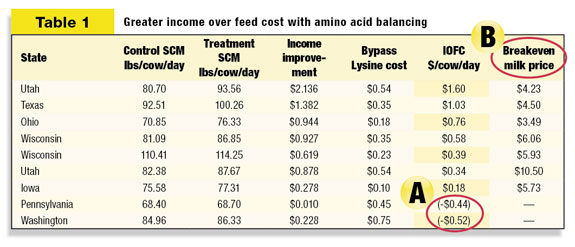Ration formulation decisions are not taken lightly. But when it comes to ration modifications, two questions steal the show: “What will this cost me?” and “What financial return can I expect?” The answers to these two questions are often the driving force behind change or the decision to keep things just the way they are.
Putting a finger on financial gains
One practice that takes much consideration before implementation is amino acid balancing. While amino acid balancing has gained greater acceptance in recent years, putting a dollar value on the expected milking string performance response can be challenging.
For example, one dairy feeding limited amino acids in their ration might see an increase in milk and component production, while another herd feeding amino acids maintains production and reduces ration protein needs. In both situations additional financial return is realized, but via two very different avenues.
Profit from different angles
To demonstrate how effective amino acid balancing can be for the dairy producer’s pocket and to showcase the avenues where financial benefits can be realized, we partnered with nine large, progressive dairy operations to conduct on-farm feeding trials.

On each dairy, lactating diets were reformulated to deliver optimal levels of bypass lysine and methionine, the two most limiting amino acids. Table 1 details the results of the nine on-farm trials.
All nine herds improved the production of solids-corrected milk (SCM) compared to herd performance prior to the ration change. It’s important to note the following details from the on-farm trials:
- Solids-corrected milk. Production responses were converted to SCM to account for improvements in milk volume, fat and protein, or a combination of all three, making it easier to compare results across farms.
- Income over feed cost. In all nine trials, feeding bypass lysine and methionine increased total ration costs; however, cost is only one piece of the equation. Income over feed cost (IOFC) is a true measure of the return on a ration change, as it accounts for income improvement above and beyond additional ration costs.
- Two of the nine herds did not show a positive IOFC even though milk and component production improved. In both cases, ration protein levels were not decreased, and the dairies were unable to take full advantage of the protein efficiency benefits of amino acid balancing.
Read my more detailed discussion of why this happened and why some dairies were better candidates than others for amino acid balancing at PeakReportOnline.com.
- In seven of the nine dairies, IOFC improved, and in some cases as much as $1.60 per cow per day.
- Breakeven milk price. This column shows a hypothetical situation to describe the price per hundredweight needed to cover the cost of the amino acid investment. In one case, the breakeven milk price went as low as $3.49 per hundredweight, showing that profits can be realized even at extremely low milk prices.
Applying the practice in your herd
While balancing amino acids is not complicated, it also isn’t as simple as adding a new feed supplement to the diet and waiting to see results. To apply the practice of amino acid balancing to your dairy’s rations, keep the following important ideas in mind:
- Opportunity exists. Regardless of your geographic location, profit potential exists with amino acid balancing. Benefits can be realized through greater milk and component production, improved nutrient utilization and feed efficiency and/or reduced ration protein needs, all translating to greater IOFC. Once amino acids are properly incorporated into the diet, performance improvements can be seen within only a few days.
- Work happens up front. With so many moving parts influencing the effectiveness of amino acid balancing, the decision to change your rations may not happen overnight. Take the time to evaluate your current ration with your nutritionist and decide how amino acid balancing can be effective in your operation.
- Team effort is a must. Work with your nutritionist to incorporate amino acids into the diet, as they know it best. This can help ensure that the ration decisions deliver the right nutrients without overfeeding protein, offering the perfect balance for your milking herd diets and your profitability.
- Change must be accepted. In the past, diets have been overformulated with protein to make sure limiting amino acids are delivered at optimal levels. Now that the ability exists to deliver precise levels of amino acids – especially those that are first limiting to milk and component production – we are able to decrease ration protein.
This has a positive effect on the environment (reducing the protein excreted by the cow) as well as on your checkbook (purchasing fewer protein inputs for your rations). While this is an emerging practice, it must be accepted for amino acid balancing to generate profits.
As you consider ration changes and ask, “How much will this cost me?” make sure to consider the other half of the equation – the financial benefit. Take time to investigate both the investment and the resulting financial opportunity to ensure you make the right decisions for your rations. PD
References omitted due to space but are available upon request to editor@progressivedairy.com .

-
Elliot Block
- Senior Manager of Technology
- Arm & Hammer Animal Nutrition
- Email Elliot Block






